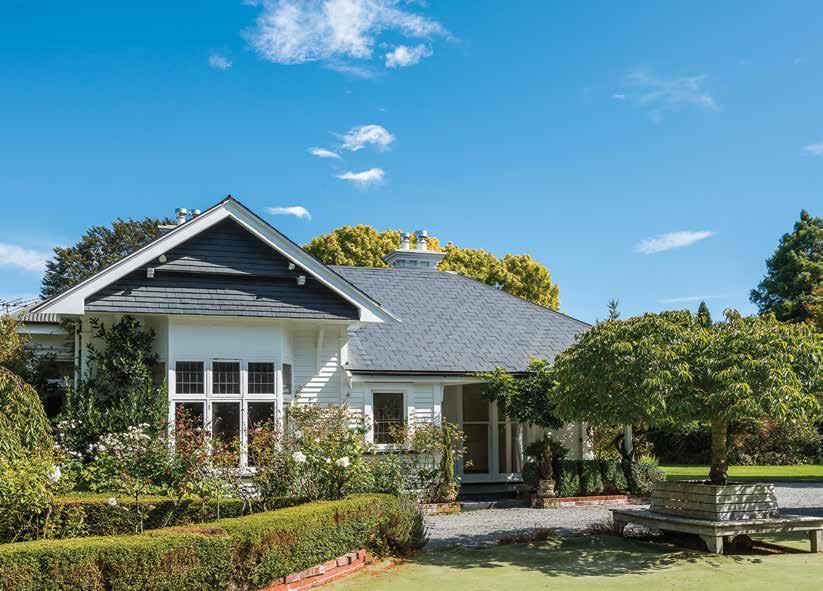
25 minute read
EDITORIAL
ANDREW COLEMAN
Some time ago, while travelling through Northland, I was asked why archaeology was important. At the time I looked across the landscape and asked the person what they saw in the distance. I was told about the rolling hills, the house, the gardens and the trees. I was then asked what I saw. I replied that I saw Māori heritage and cultural landscapes and that it was mostly under the ground – under the rolling hills, the colonial house and the adapted gardens, trees and vegetation. I also explained that it was for this reason that archaeology and its regulation through authorities played an important role in ensuring that Māori heritage and history was able to be understood and told into the future.
The truth is that it is the archaeological authority process and programmes such as Mātauranga Māori that will ensure our cultural landscapes and full heritage will endure. It is a delight to have the Mātauranga Māori programme highlighted in this edition of Heritage Quarterly .
In reviewing and resetting the strategy for Heritage New Zealand Pouhere Taonga, our Board and Māori Heritage Council has challenged the organisation to ensure that there is a balance in our work with more emphasis on Māori heritage and history.
Each of the stories in this edition allows us to ask questions about the history of Aotearoa New Zealand.
The opening of Te Whare Waiutuutu Kate Sheppard House last December was indeed
The prominence and importance of Māori heritage
a fantastic occasion and the interpretation that tells the stories of Kate Sheppard and the Suffrage Movement are certainly stunning. It is timely to ask: what preceded the current house being there, what are the stories of the Clyde Road area of Christchurch (or indeed the wider Ōtautahi area) for Māori, and what was the cultural landscape like?
Another example of the breadth of future thinking, based on a full awareness of the past, is Waiuta. What a fantastic addition to the Tai Poutini West Coast Tohu Whenua programme. It is one that was significantly contributed to by a dedicated and committed Friends of Waiuta group. If you follow with interest the story of Waiuta you will read about the early 1900s and the formation of what was recalled as a ‘raw and new town’ that was established to support the mining ventures. This story in itself is impressive, but again the whenua at Waiuta has a longer history than the early 1900s and a likely very significant Māori history that Ngāti Waewae is looking to have told. The Hoffman Kiln in Palmerston North, the site of the Ataturk Memorial in Wellington and the Chatham Islands all feature in this edition. The stories are about a point in time and the questions can now be asked on what preceded that time.
One might ask why the emphasis change? Heritage and history is required to be in the New Zealand Education Curriculum, and knowing this full and comprehensive past allows a richer contribution to be made. Importantly for us at Heritage New Zealand Pouhere Taonga, if we are asking then we can be quite influential in how this develops for all New Zealanders. We can fulfil our role as the advisors, guardians and kaitiaki of heritage.
Waitangi Day was recently marked with our staffed properties being open to the public free of charge. It is timely to reflect on Māori and colonial heritage, not just on this day, but every day. We hope New Zealanders increasingly ask the question of what was at these places before the construct of a colonial building took place.
It is time for a broader consideration of heritage. n
ANDREW COLEMAN
CHIEF EXECUTIVE
The Prime Minister, the Rt Hon Jacinda Ardern, opened Te Whare Waiutuutu Kate Sheppard House in Christchurch on Tuesday 15 December. This special celebration marked the completion of the visitor experience, telling the story of Kate Sheppard and other women who worked tirelessly to achieve women’s suffrage.
The former home of suffragist Kate Sheppard was the centre of the campaign to secure the right for New Zealand women to vote. It was purchased by the Government in 2019, and is now cared for by Heritage New Zealand Pouhere Taonga.
The house is now open to the public on weekends, and visitor feedback has been glowing. The entranceway and four front rooms have been transformed into a visitor experience, which conveys the story of Kate and her suffragist contemporaries, as well as the experiences of Māori women and the ongoing efforts by New Zealand women for equality. “People are just thrilled with the mix of modern exhibition design and period elements,” says Property Lead for Te Whare Waiutuutu Kate Sheppard House, Helen Osborne.
“We were so fortunate to be donated many items belonging to Kate, and appropriate Victorian furniture. But the exhibition design by StoryInc also includes many clever hidden surprises that people love.”
The process for exhibition design included a reference group with representatives from Heritage New Zealand Pouhere Taonga, the Universities of Canterbury and Otago, Canterbury Museum, Kate’s family descendants and members of Te Rūnanga o Ngāi Tahu.
“It’s given the exhibition a real depth to have such a breadth of expertise and research going into it,” says Helen.

2
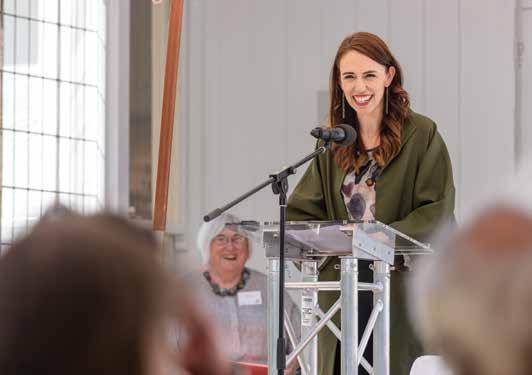
4 5


The property is child-friendly, with dress-up clothes and a fun trail of clues led by Kate’s parrot, Polly Plum. The shop is already proving popular, with books and camellia earrings in high demand. And, after taking time to explore the exhibition, there are plenty of spots to sit and take in the stunning garden. Heritage New Zealand Pouhere Taonga staff and associated contractors put in a huge amount of effort to get the exhibition and property ready, and are thrilled with the positive responses.
Heritage New Zealand Pouhere Taonga manager heritage assets southern, Dr Christine Whybrew, says she and the team feel honoured to care for the house.
“It’s so exciting for us to share the Kate Sheppard story with visitors from New Zealand and the rest of the world. Because New Zealand was the first country to give women the right to vote, this place is internationally significant in the wider story of universal suffrage.”
At the opening event, the Prime Minister spoke movingly about how she hoped that the house would have an ongoing life as a place as a venue for thought and debate. Also, that the house will bring people closer to their history, and particularly inspire young women to feel that everything is possible. Currently, the back of the house is being renovated into function and meeting rooms that can be used by the community for this purpose.
Once the house is finished, it will be open on weekdays and used for school group tours and events. n Writer: Rosemary Baird
6
1. Te Whare Waiutuutu Kate Sheppard House in Christchurch. 2. The Prime Minister, the Rt Hon Jacinda Ardern, speaks at the reopening of the house. 3. Property Lead for Te Whare Waiutuutu Kate Sheppard House, Helen Osborne. 4. The Prime Minister looks at interpretation panels. 5. Te Whare Waiutuutu Kate Sheppard House is open to visitors. 6. Paying respect to Kate Sheppard. 7. A glimpse at the wonderful gardens and green space.
(CREDIT: CHRIS HOOPMANN FOR HERITAGE NEW ZEALAND POUHERE TAONGA – ALL PHOTOS)
We will remember on Anzac Day
New Zealanders will be hoping they can resume attendance at this year’s Anzac Day on 25 April, unlike last year when the country was in lockdown due to the pandemic.
Planning for one of the country’s most important days has been led by the New Zealand Returned Services Association, wishing to restore the large numbers who want to personally pay respect to those who served and died for this country at our many memorial sites up and down New Zealand.
One very special place of assembly for hundreds of people each year has been the Ataturk Memorial in the capital. The Wellington memorial was unveiled on 26 April 1990. It features the bust of Mustafa Kemal Ataturk, commander of the Ottoman 19th Division who played a pivotal role in frustrating the efforts of Allied forces to seize the Dardanelles during World War I. His army helped to contain the initial landings at Anzac Cove before re-taking the crucial heights of Chunuk Bair. Mustafa Kemal Ataturk would later become the first president of modern Turkey. In 1934, he was granted the honorary surname of Ataturk, ‘Father of the Turks’.
The Ataturk Memorial is situated on a ridge above Tarakena Bay on the south coast of Wellington. It looks out over Cook Strait, with the site chosen for its remarkable resemblance to the Gallipoli Peninsula landscape. It is accessible at all times with a short walk from the carpark to the memorial.

The Ataturk Memorial came about as the result of an agreement between the Turkish, Australian and New Zealand Governments. In 1984, the Australian Government asked the Turkish Government if the cove on Gallipoli Peninsula could be renamed Anzac Cove in memory of the Australian and New Zealand troops who lost their lives there in 1915 during the Gallipoli campaign.
The Turkish Government agreed to a name change from Ari Burnu and also built a large monument to all those who died in the campaign. In return, the Australian and New Zealand Governments agreed to build monuments in Canberra and Wellington to Mustafa Kemal Ataturk. The Wellington memorial was designed by Wellington and Nelson conservation architect, Ian Bowman.
“The basis of the design was the Turkish crescent and star, and the crescent was extended vertically,” says Ian.
“The white marble formed the crescent and star and the design for the podium extended the star form in white marble lines to the edge of the podium. The red marble was the red background in the flag. The wall behind and the bulk of the paving was designed to reflect
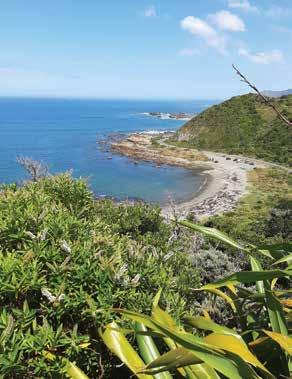
2
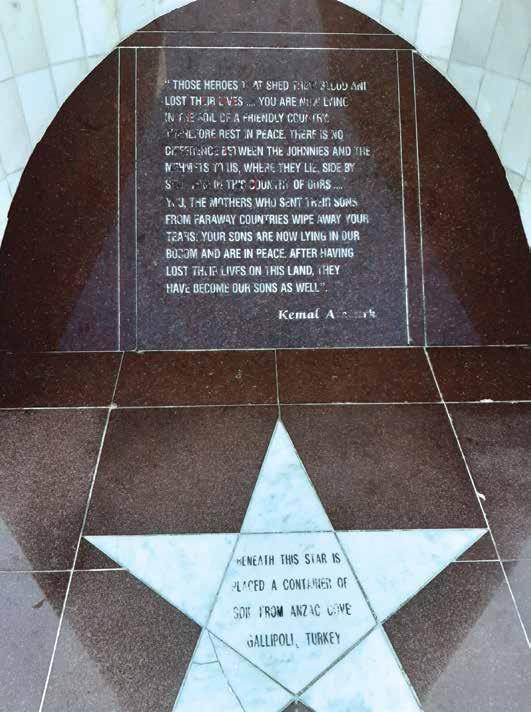
the rocky shore. A capsule of soil from Gallipoli was buried under the star in the centre of the podium and the bust of Mustafa Kemal Ataturk was provided by the Turkish Embassy.”
The memorial was unveiled by the Turkish Minister of Agriculture. There were several hundred invited guests present, including community leaders and school representatives.
In 1999, a paved forecourt and pathway, also designed by Ian Bowman, were added with funding from the Turkish Government. The memorial features a message of reconcilation, widely attributed to Mustafa Kemal Ataturk. It reads:
Those heroes who shed their blood and lost their lives, you are now lying in the soil of a friendly country. Therefore rest in peace. There is no difference between the Johnnies and the Mehmets to us where they lie side by side in this country of ours. You, the mothers who sent their sons from far away countries wipe away your tears, your sons are now lying in our bosoms and are in peace. After having lost their lives on this land they become our sons as well.
Wreath laying services are held at the memorial on Anzac Day and in August each year by the Wellington Company of the Wellington and Hawke’s Bay Battalion Group to commemorate the Battle of Chunuk Bair. The Ataturk Memorial is maintained by the Ministry for Culture and Heritage while the Kemal Ataturk Reserve where the memorial is located and the surrounding Rangitatau Reserve are maintained by the Wellington City Council. In 2017, the Turkish Memorial was unveiled at Pukeahu National Memorial Park.
Health and safety conditions allowing, wreath laying and remembrance addresses will be given again at the Ataturk Memorial in Wellington on 25 April this year. n Writer: David Watt (David attended the unveiling ceremony in 1990 as the then deputy Mayor of Wellington City)
1. The Ataturk Memorial in Wellington. 2. Mustafa Kemal Ataturk’s message of reconciliation and respect. 3. The view to Cook Strait from the memorial site.
(CREDIT: DAVID WATT/HERITAGE NEW ZEALAND POUHERE TAONGA – ALL PHOTOS)
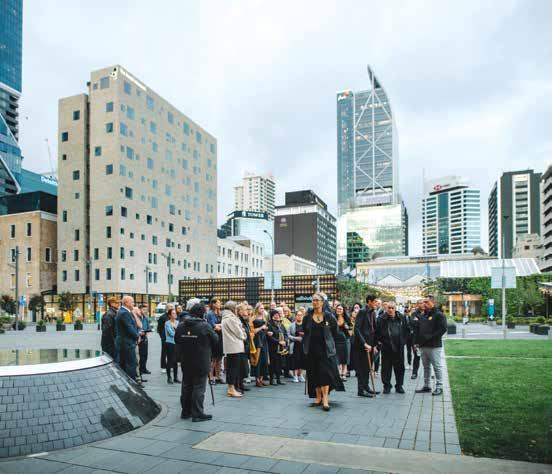
1

Stunning heritage canvas in Auckland
The Britomart Precinct in downtown Auckland has undergone a series of enhancements in recent years, with its unique heritage-listed buildings central to the precinct’s identity.
Originally a complex of industrial warehousing built to support the import and export harbour trade, these former merchant stores are now home to designer boutiques, eateries, bars and offices. Part of a landmark exhibition of contemporary Māori art, four significant public artworks have been installed at Britomart.
A five-storey high mural by Shane Cotton (Ngāti Rangi, Ngāti Hine, Te Uri Taniwha), titled Maunga, and painted on Excelsior House is the cornerstone of Britomart’s satellite exhibition of Auckland Art Gallery Toi o Tāmaki’s Toi Tū Toi Ora: Contemporary Māori Art. It brings contemporary Māori art outside the walls of the gallery and into the streets of downtown waterfront Auckland.
Heritage New Zealand Pouhere Taonga has been involved with providing heritage advice on the project. “All four artworks have been well integrated into the Britomart heritage precinct, but only one, Shane Cotton’s mural on the Commerce Street side wall, is physically part of a listed heritage building (the Excelsior building),” says Heritage New Zealand Pouhere Taonga Senior Conservation Architect, Robin Byron. “Because the wall itself was not an original wall with historic and decorative features, Heritage New Zealand Pouhere Taonga could support its use as a canvas – especially as the artwork links meaningfully to the history and culture of the area, valuably contributing to the heritage environment and urban experience.”
The working relationship between Heritage New Zealand Pouhere Taonga and the Britomart Group has been ongoing. “Britomart prides itself on the sensitive adaptation of its buildings for contemporary use, something we’ve worked on with Heritage New Zealand Pouhere Taonga for almost 15 years,” says Jeremy Hansen, Britomart Project Manager leading the project. In addition to adding value to the precinct through public art, there has been careful consideration for the heritage landscape. “When we were planning Shane Cotton’s Maunga mural, we knew Excelsior House had been cut in half to allow the widening of Commerce Street in the 1930s, but we still wanted to ensure we didn’t compromise the building’s remaining heritage values. We sought expert advice from Heritage New Zealand Pouhere Taonga from the outset and it was a very satisfying collaboration, resulting in a new piece of public art we hope will be appreciated for decades to come.”
Shane Cotton’s contribution is joined by the work of three other artists: Lonnie Hutchinson, Charlotte Graham and Master Carver, Lyonel Grant. The commissions were officially opened with a dawn karakia in December led by
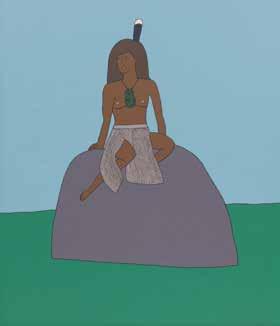
2
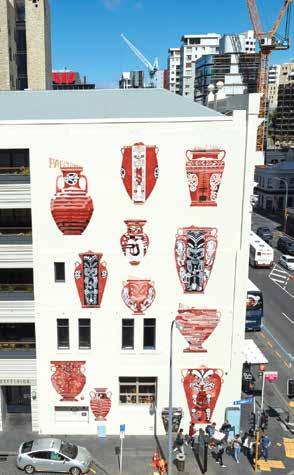
representatives of Ngāti Whātua Ōrākei. Heritage New Zealand Pouhere Taonga was represented by Robin Byron. All these works will be on display until late March. n Writer: Antony Phillips
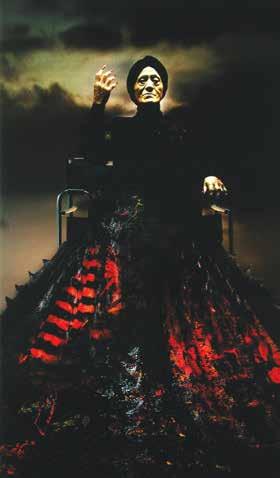
1. The dawn karakia.
(CREDIT: RUSS FLATT)
2. The mural by Shane Cotton on Excelsior House.
(CREDIT: RUSS FLATT)
3. Mei, by Ayesha Green.
(CREDIT: AUCKLAND ART GALLERY TOI O TĀMAKI)
4. Mahuika, by Lisa Reihana.
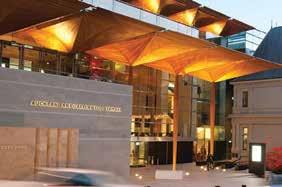
(CREDIT: AUCKLAND ART GALLERY TOI O TĀMAKI)
5. Auckland Art Gallery.
Toi Tū Toi Ora: Contemporary Māori Art
The Auckland Art Gallery Toi o Tāmaki is featuring a major new exhibition of contemporary Māori art. Toi Tū Toi Ora: Contemporary Māori Art is the largest exhibition in the art gallery’s history, featuring work by more than 100 artists including Ralph Hotere, Robyn Kahukiwa, Lisa Reihana, Michael Parekowhai, Reuben Paterson and Cliff Whiting. In addition to customary art forms such as carving, weaving and painting, Toi Tū Toi Ora features innovative moving image and digital media art showing that Māori culture is nuanced, vibrant and diverse.
The title of the exhibition speaks to the challenge and aspiration for Māori art to continue to stand tall (toi tū) and stay healthy (toi ora). Māori artists have long used their art practice to direct attention to issues of health and well-being both for people and for Papatūānuku (earth mother). Jim Schuster, Heritage New Zealand Pouhere Taonga Pouarahi Traditional Arts, attended the dawn opening of the exhibition. It features work by his mother Emily Schuster, the renowned Te Arawa/Tūwharetoa weaver. Jim believes the exhibition celebrates the Māori world and honours the expert practitioners who created the works. “Mīharo rawa atu ngā mahi toi o ngā tohunga ringa rehe o te ao Māori. He whakaaturanga tēnei, hei whakanui i te ao Māori ki roto i te ao Toi. Tēnei ka mihi ake, ka tangi ake hoki ki ngā ringa rehe katoa, arā ko rātou kua whetūrangitia, ā rātou hoki o te kanohi ora.
"The artworks of the skilled artists of the Māori world are truly amazing. This exhibition promotes the Māori world within the world of art. I salute and weep for our art experts who have gone to the heavens and humbly acknowledge those who are still with us today." Toi Tū Toi Ora: Contemporary Māori Art is a free exhibition and on display at the Auckland Art Gallery, Corner Kitchener and Wellesley Street, until 9 May 2021. n Writer:Tharron Bloomfield
WEST COAST
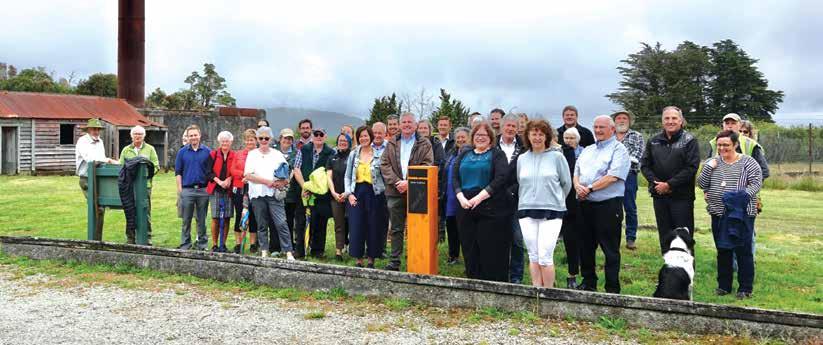
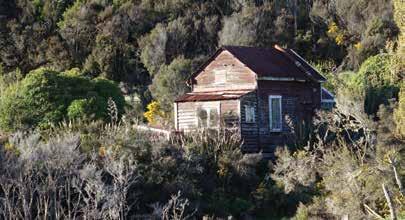
2
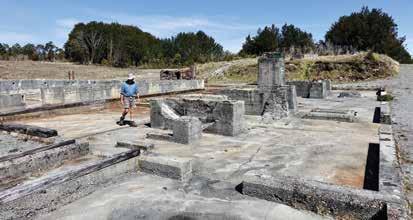
Waiuta celebrates Tohu Whenua status
The longest inhabited early West Coast gold mining settlement, Waiuta, is now a Tohu Whenua. About 50 people gathered at the end of last year to celebrate the former town’s new status and recognise it as one of Aotearoa New Zealand’s best heritage visitor experiences.
“It was fantastic to see so many people with a shared passion for this significant site come together,” says Andrew Coleman, Heritage New Zealand Pouhere Taonga Chief Executive and Chair of the Tohu Whenua Governance Group.
“This was a celebration of the significance of Waiuta and an opportunity to pay tribute to the people who have looked after this special place for decades and continue to do so.”
Waiuta grew out of the last great gold discovery on the West Coast – the Prohibition and Blackwater mines producing nearly 750,000 ounces of gold (worth $1.6 billion in today’s currency) between 1907 and 1951. It is more than just a mining story though. It is one of how people lived in remote settings in comparatively recent times.
Several historic buildings remain to tell the stories of the people who once lived and worked there – a peak population of 600 in the 1930s. Miners from all over the world came to Waiuta with their families, and the isolated setting gave rise to a strong and vibrant community. The working and social lives of the bustling company town were captured in a remarkable collection of photographs by miner Jos Divis, some of which can be seen in the story-filled interpretation panels throughout the town.
After the Blackwater Shaft collapsed in 1951, the mines were closed and the town with it. People started leaving within weeks in search of jobs elsewhere and most of the buildings were removed. Scrub quickly reclaimed the site. The abandoned town gained the attention of historians in the 1980s when it became clear there was still a strong cultural identity among past residents who visited the town and kept in touch with each other. The Forest Service instigated a series of oral histories alongside the Friends of Waiuta Society, which set out to preserve the history of the town. The Friends continue their work and
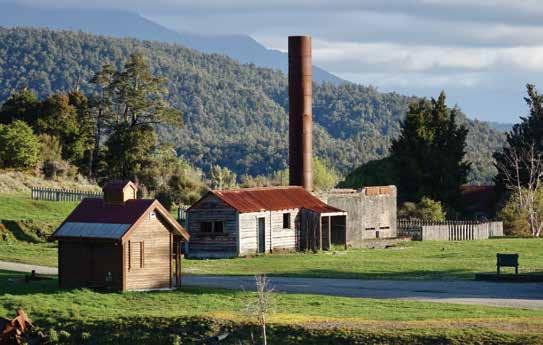
4
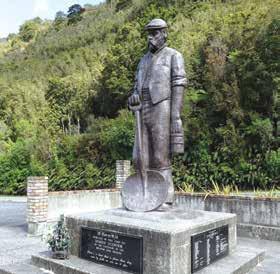
last year launched a documentary about the town called Whispers of Gold. Waiuta is now managed by the Department of Conservation Te Papa Atawhai and cared for in partnership with the Friends of Waiuta.
How to get there Waiuta is located half-way between Reefton and Greymouth. It is signposted from SH7, 21km south of Reefton. Turn onto Waiuta Road, turn right onto Blackwater Road and follow it to the end.
What to do and see Waiuta is best explored on foot, but there is plenty of scope for an e-bike adventure. The most impressive remains are those of the goldmine, especially of the Prohibition shaft, which is located on the hill above Waiuta. The shaft was 879m deep, the last 275m of which were below sea level! The 2.5 hour return track to Snowy Battery is also worth the effort. This is where gold was pounded out of quartz rock using the water-powered ‘battery’ of iron stampers, before being further processed in colossal cyanide tanks that still stand by the river.
Several good tracks that follow the layout of the town’s former roads lead past an Olympic- sized swimming pool, a rugby field with posts still standing, Waiuta Lodge (faithfully modelled after the hospital that stood on this site and now operated as a bookable DOC hut), the restored barber shop, police lock-up and several cottages that include that of photographer Jos Divis. The highlights of Waiuta can be seen in a day, but short stays in self-contained campervans are welcome for those who want to take their time (note that caravans should not attempt the drive from Blackwater to Waiuta due to the narrow, windy gravel road that has precipitous drop-offs and no passing bays).
Waiuta is the fifth heritage site on the West Coast to be awarded Tohu Whenua status, joining the ranks of Brunner and Denniston Mines, Historic Reefton, and Hokitika Port, Commercial and Government Centre. Tohu Whenua are places that have shaped Aotearoa New Zealand. Located in stunning landscapes, and rich with stories, they offer some of our best heritage experiences. n www.tohuwhenua.nz
Writer: Claudia Babirat
1. The Tohu Whenua post was unveiled in front of 50 guests including members of the Friends of Waiuta, local MP Damien O’Connor, representatives of Ngāti Waewae, local government, Tohu Whenua partner agencies and the local community.
2. At the site of the Prohibition shaft.
3. The old police lock-up.
4. Looking towards Blackwater shaft.
5. The memorial to 65 miners who lost their lives in the Brunner Mine explosion.
Brunner 125th anniversary
This year marks the 125th anniversary of New Zealand’s worst workplace disaster – the Brunner Mine explosion. Brunner was once the largest producer of coal in New Zealand but the dangers faced there were many. When a sound like artillery fire was heard throughout the then bustling town at 9.30am on 26 March 1896, with very little evidence on the surface, the onlookers knew the explosion had happened deep inside the mine. As word spread fellow miners came from Blackball, Greymouth and Westport to join the gruelling rescue operation. The last body was recovered the next day. Almost half of the Brunner workforce was lost and families were shattered. The funeral procession of 6,000 people stretched half a mile. A government inquiry followed and the mining company was cleared of any negligence. The disaster spurred changes in New Zealand society though, giving rise to a stronger union movement and improved safety legislation, Brunner’s legacy today. These days you can walk through the industrial ruins on both sides of the Grey River, which are joined by a classic suspension bridge. Allow at least one hour to explore the large range of mining remnants, beehive coke ovens, brick factory and tunnel entrances and the 65 step memorial, all set in a lush green setting 11km east of Greymouth on SH7. Brunner Mine is proudly cared for by the Department of Conservation Te Papa Atawhai, and has been recognised as one of 25 Tohu Whenua, places that capture defining moments in Aotearoa New Zealand’s story. n
Hoffman Kiln Trustees pleased with conservation progress
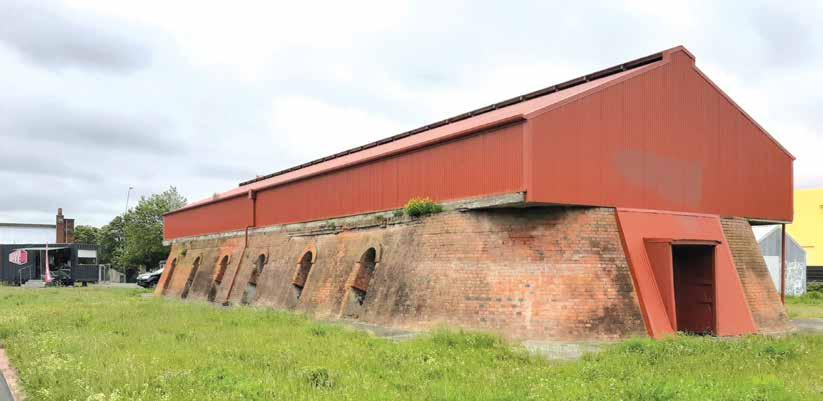
When the Hoffman Kiln Trust took over ownership and management of the 116-year-old kiln site in Palmerston North some years ago from Higgins Group Properties, they had little idea how much work was required for its future conservation and preservation.
Trustee, David Chapple, a well-known retired Manawatū architect, looks back on that decision and still scratches his head knowing they had taken on a monumental challenge.
“I have to say, though ... in all we have been through as a country in Covid times we have achieved a lot with our kiln plans and I am particularly pleased with the progress we are making through our voluntary work efforts.”
Cliff Wilson, former Chief Financial Officer for the Higgins Group, is chair of the Trust. He has always had a strong passion for the kiln, and was instrumental in getting the new trust formed. Cliff and David, and other trustees, are making progress towards showcasing the significance of the Category 1 listed kiln, which also has a heritage order on it from the Government. The Hoffman Kiln is an imposing building of national heritage value that provides a rare insight into New Zealand’s brick-making history in Palmerston North.
Built around 1904, the Hoffman Kiln is a unique example of a continuous kiln, a type common in industrial countries from the mid-19th century. At its peak in production, the Hoffman Kiln in Featherston Street could produce up to 9,000 bricks a day. The decline in the use of bricks for buildings following the 1931 Hawke’s Bay earthquake, the effects of the Depression years, and the diminishing amount of locally available clay eventually made the kiln uneconomic to run. It was fired for the last time in 1959.
In 2014, the roof and superstructure of the kiln were destroyed in a storm and were replaced by the then owners of the kiln and surrounding land, Higgins Group Properties. The following year an agreement was reached to enable the land to be subdivided, with the land containing the kiln and former office block at the front of the property to be transferred to a trust.
“We have pushed on doing what repairs we have been able to undertake to the buildings on-site, repairs on brick work, general maintenance around the site and trying to reduce vandalism, which has been a constant issue over many years,” says David.
“Ground maintenance is a high priority, especially at this time of year. The council helps us to keep the grass down.”
Protection of this important place is a constant issue. The late Jim Lundy, a highly respected historian in Palmerston North, spent a lot of time at the kiln trying to protect it against vandalism.
“Dealing with vandalism took up a lot of Jim’s time, in fact all our time too, in protecting this community asset. Security cameras are being installed to assist us to deal with this problem.

“Jim Lundy was the author of the book Nine Thousand Bricks a Day, the authoritative story on the history of the Hoffman Kiln. He was a friend to many and we miss him today as we undertake new phases of conservation and preservation work.
“We are working on a former storage shed, converting it to an exhibition area with display materials of bricks manufactured and the history of the kiln operations. We have already made this material available at open days. Volunteers are giving of their time to finish the interior of the shed so we have something to be proud of. Jim would certainly have been proud of this, so visitors can follow the story of brick-making and the impact the kiln had in the Manawatū district. When we are finished, we will be calling this the Jim Lundy Building,” says David.
When the land was subdivided, a Medical Centre was built adjacent to the kiln building. This business brings a huge amount of daily traffic to the site. Between the former front office and the kiln a coffee cart operates five days a week. It has been there three years and provides a very good presence on this open industrial site. The owners have supported efforts to protect the kiln and have used their business to promote sales of merchandise on behalf of the Kiln Trust.
“In addition to the Jim Lundy Building we are renovating the front office block, which will provide an entry to our site operations. We will be able to hold meetings in the building and have promotional material for visitors. And, from here, our priority is to install special interpretation panels made at the front of the kiln so people can learn about its history and achievements. We would like to try and achieve this by November when Palmerston North has its next Heritage Week. “We are planning to approach the council, our regional heritage organisation, Historic Places Manawatū-Horowhenua and Heritage New Zealand Pouhere Taonga to help us with this task and, with their advice and support, ensure our kiln remains a heritage landmark in Manawatū,” says David. n Writer: David Watt
1. The Hoffman Kiln, looking east to Featherston Street, Palmerston North.
2. David Chapple, Hoffman Kiln Trustee, and Cindy Lilburn, Chair Historic Places ManawatūHorowhenua, look at content going into the new exhibition space.
(CREDIT: DAVID WATT/HERITAGE NEW ZEALAND POUHERE







